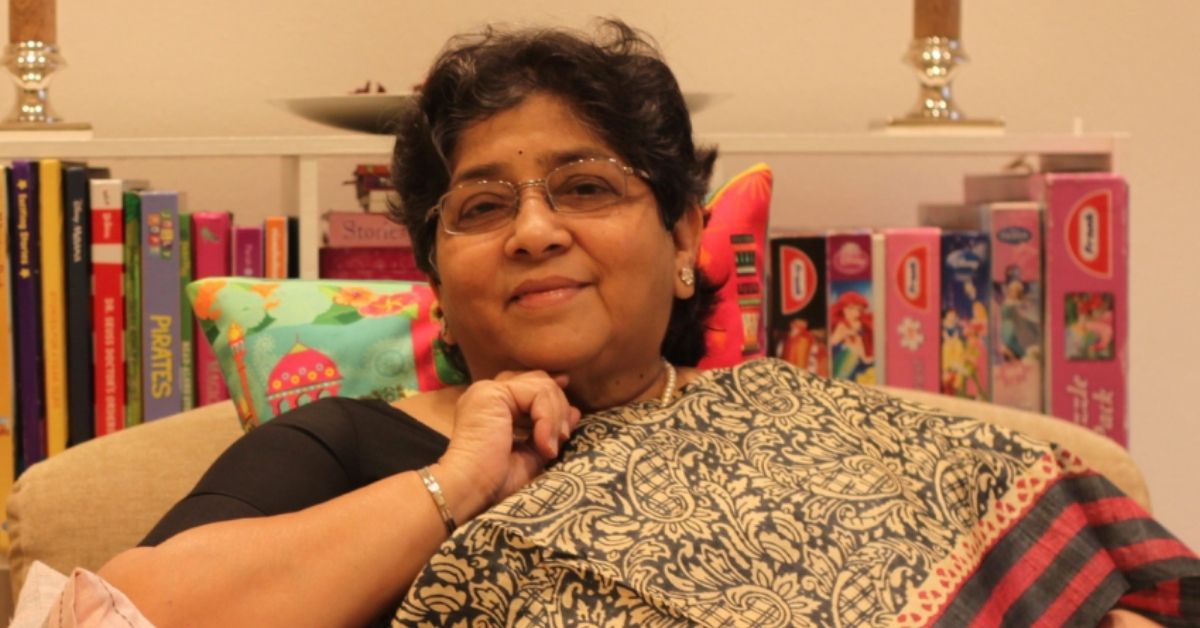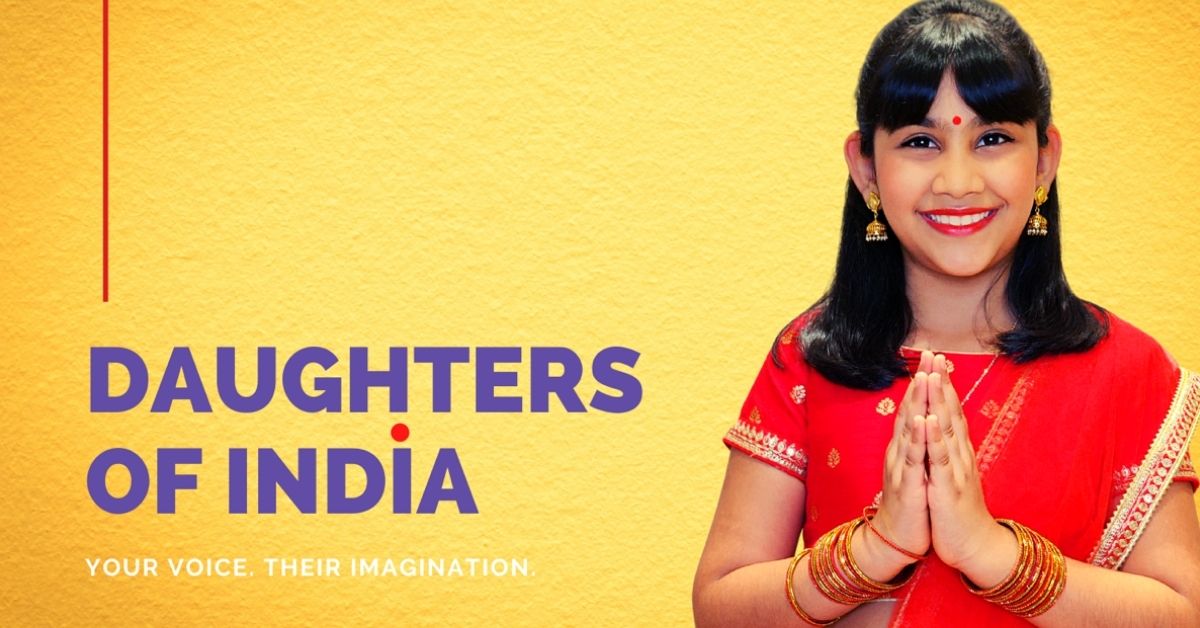On This Mom’s Platform, 120 Elder Narrators Share 3500 Tales in Over 22 Languages
Mumbai-based Shikha Dalmia started Spin a Yarn with her mother-in-law, Madhurata Deshmukh in 2018. The platform has over 120 narrators, most of them senior citizens, who narrate children’s tales in the 22 languages recognised by the Indian constitution.

Storytelling is the oldest form of teaching. Besides improving literacy skills, this oral tradition forms a child’s curiosity and imagination, cultural understanding, social skills and focus. In a country as diverse as India, storytelling, in its various forms, is one of the first avenues in helping preserve our heritage and history. And languages play an important role in this too.
Mumbai-based Shikha Dalmia (39), a mother of two who started Spin a Yarn (SaY) in 2018 with her mother-in-law, Madhurata, found that a lot of the times, resources to access stories in native languages were limited.
“I’m a Marwari, and my husband is Maharashtrian. So my family is quite multicultural. When I wanted to teach my kids Hindi and Marathi, I found that the resources available failed to showcase these languages in their purest forms. Even Hindi here has evolved to become very ‘Mumbai-centric’. The Hindi we speak in the North and the one we speak here are completely different,” Shikha tells The Better India.
Madhurata Deshmukh (67) began narrating stories to her grandchildren in Marathi, so they could build their grasp over the language. “These are stories we have all grown up hearing, but she would always add her own twists to them. The children wouldn’t find these tales anywhere else,” Shikha says.

When Madhurata went to the US, for around five months, Shikha’s children began missing these stories terribly. As a passing suggestion, Shikha asked her mother-in-law to record herself narrating these stories and send them across to her. “My mother-in-law’s stories helped my kids familiarise themselves with words they hadn’t even learned in school yet. Sometimes, even the teachers were in awe of certain words they used, which they wouldn’t expect these kids to know,” she says.
On Madhurata’s return, the two women sat to discuss the positive changes they were seeing in the children’s language skills. This experience gave birth to SaY, an online storytelling platform that calls upon narrators of diverse cultures to read out children’s stories in the 22 languages recognised by the Indian constitution.
Preserve, protect, promote
“I thought there must be so many women, like my mother-in-law, who are so learned and have such a strong grasp over their native language but don’t have many options to express themselves. I wanted to amplify their voices in a way that these languages can be preserved, protected, and promoted,” she says.
Shikha says that stories narrated by elders formed a large part of the experiences and memories of her generation, something that she finds is missing today. “Obviously, modernisation and nuclear families have led to this shift but there must exist a balance that keeps a generation rooted in their culture. People want English as their primary mode of communication, but this often leads to kids feeling embarrassed to use their native tongue these days. As we grow older, we look for something that offers us familiarity and comfort. And there’s nothing better than your own culture to fall back on,” she says.
The same sentiment is echoed by 85-year-old Rama Kejriwal from Rajasthan, one of SaY’s oldest narrators, who tells children slokas and stories in Sanskrit and Hindi. “The biggest problem we elders face is that unfortunately, we don’t get a chance to pass on our learnings and experiences to younger generations, especially our grandchildren. Everyone is so busy these days that they have little time to sit down and enjoy stories the old fashioned way. But through SaY, I get the opportunity to reach out to different children,” she tells The Better India.
‘Stories are like khichdi’
SaY began with around 8-10 narrators, who were all Shikha’s extended family members or friends. “We posted a few audio recordings and videos, and I shared it with my friends,” Madhurata says, adding, “They loved it, and said they wanted to show these videos to their grandchildren, and asked if I would do more. I said, ‘Of course, I would love to, but why don’t you do it too?’”
Today, SaY has around 120 narrators, who come from all spheres of life to narrate their stories to children. They don’t come here for any monetary gains but purely for their love of stories and language.
The stories on SaY are a combination of already-existing tales and new ones that the narrators wish to introduce. “I always say — stories are like khichdi. Every house has its own variation and way to make it. So even on our platform, every story has a different twist or version that’s offered by the narrator,” Shikha says.
Madhurata says that while stories in native languages might be available on YouTube, they are mostly in animated form, and have horrible grammar. SaY helps children hear tales in the purest form of the language. With the many psychological and educational benefits of storytelling, what elevates this experience is the presence of an elderly figure, who is often a wise, learned grandparent adding a sense of warmth and comfort to the child’s learning process.
“My mother-in-law narrates this story called Chal Re Bhoplya Tunuk Tunuk, which is a Marathi tale. This version was written for her by her own mother, some 60 to 70 years ago, which you won’t find anywhere else,” Shikha adds. The platform has over 3,500 such tales as of now.
SaY — beyond storytelling

“Currently, we narrate stories in 22 languages, and aim to cover around 70-75 by February 2021,” Shikha says, adding, “We also keep in mind that every region or area has their own version or dialect when it comes to a language.”
For this reason, SaY is also working with over 600 public schools in Mumbai for their Read Aloud project. Here, the parents are encouraged to read stories out loud to children in their respective native languages. Sometimes, they dress up in the attire of their respective states to add to the experience. “When you read aloud to children, there’s more room for them to be able to express themselves with you, as opposed to what they would do while reading alone. It leads to more discourse,” Shikha says.
SaY has also partnered with the Government of India’s Bhasha Sangam to promote regional languages. In 2019, which the United Nations declared the Year of Indigenous Languages (IY2019), it was the only Indian organisation to partner with UNESCO to preserve these languages.
When the COVID-19 pandemic began, the platform saw an increase in the number of narrators and children. “Many people shed their inhibitions, in terms of fear of facing an audience or being sceptical of the internet as a safe space for kids, and came to join our platform,” Shikha says. SaY also distributed dongles among underprivileged kids, so they, too, could have access to these stories online. Through donations, and contributions from friends and family, Shikha was able to raise Rs 9 lakh for this endeavour, all of which was invested towards this cause.
Shikha’s 9-year-old daughter, Anaya is also an active member on the storytelling platform. Shikha says, “We gave her this book called Good Night Stories for Rebel Girls. When she read it, she was disappointed that there were only two Indian women in it. At the time, she was also learning some basics about gender disparity in her school and was quite disheartened by the lack of awareness of how much women in Indian history have achieved.”

That is how they started the Daughters of India project. The programme began with Anaya recording short episodes on powerful women that have made an impact throughout history. She finds the story of how Rani Lakshmibai fought a battle with a baby on her back to be the most inspirational. “I have recorded 8 out of the 12 episodes so far,” she tells The Better India.
While the podcast began with just Anaya, around 22 more kids, both boys and girls, have since joined in.
‘Magical fairytales’
For Madhurata, the best part about narrating stories is coming up with new ideas and introducing new concepts to the tales for the kids. She says her favourite stories to narrate is that of how Krishna would steal butter, mostly because it is Anaya’s favourite. “Every night, I told her a different version of how his mother would hide the butter and how he and his friends would then find it. Anaya’s friends also used to come to listen to these stories and we’d all enact it out loud,” she says.

Meanwhile, Rama says narrating stories on SaY gives her a feeling of immense satisfaction and accomplishment. “Today, as I see my grandchildren grow and lose their ability to talk in their mother tongue, it saddens me. I hope that SaY India can capture the voice of our generation so that our future generations can benefit. Hopefully, the children can learn one or two things from my stories and talks, and use it to better their lives. ” she says.
Many such stories exist on SaY’s platform. Shikha’s endeavour has neatly tied in two separate generations under one ambit — meaningful storytelling. The elders, with all their sage wisdom, have found a way to express the tales that bind our history, and the children have found a way to embrace native languages amid the fast-moving and ever-changing modern world.
Shikha sums up SaY’s efforts in one sentence. She says, “Spin a Yarn is on a mammoth mission to preserve the magical fairytales and cultures of India.”
To hear the tales that are bringing young children closer to India’s many languages, you can visit Spin a Yarn’s website.
Edited by Yoshita Rao
If you found our stories insightful, informative, or even just enjoyable, we invite you to consider making a voluntary payment to support the work we do at The Better India. Your contribution helps us continue producing quality content that educates, inspires, and drives positive change.
Choose one of the payment options below for your contribution-
By paying for the stories you value, you directly contribute to sustaining our efforts focused on making a difference in the world. Together, let’s ensure that impactful stories continue to be told and shared, enriching lives and communities alike.
Thank you for your support. Here are some frequently asked questions you might find helpful to know why you are contributing?


This story made me
-
97
-
121
-
89
-
167











